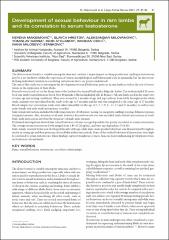| dc.description.abstract | The drive to mate females is variable among the rams and can have a major impact on sheep production. Androgen testosterone
may be a key mediator within the expression of various morphological and behavioural traits in mammals, but the factors underlying individual variation in circulating testosterone levels are poorly understood.
The aim of this study was to investigate the development of sexual behaviour patterns in ram lambs as well as the role of testosterone in the expression of their libido.
Research was carried out on the sheep farm of the Institute for Animal Husbandry, Belgrade, Serbia. The study included 20 crossbred ram lambs (autochthonous breed Pirot Pramenka x Merinolandschaf x Ile de France). All ram lambs used in the study were
of same age and rearing conditions. They were weaned at 2 months of age and kept indoors from birth throughout the whole
study. Animals were introduced in the study at the age of 3 months and the trial was completed at the rams’ age of 17 months.
Blood samples for testosterone levels were taken bimonthly (at the age of 3, 5, 7, 9, 11, 13, 15 and 17 months), as well as were
male-female and male-male interactions recorded.
Male-female interactions included the following elements of behaviour: nosing (or anogenital sniffing), pawing, flehmen response,
attempted mounts. Also, duration of all male activities directed towards ewe was recorded (male-female interactions in total).
Male-male interactions involved the frequency of male-male mounts.
Performed investigations showed that sexual behaviour of rams was age dependent, but poorly correlated to serum testosterone.
The average serum testosterone levels ranged from 1.83-13.28 ng/mL, and were age dependant (P<0.05).
Male-female oriented behaviour developed linearly with age, while male-male specific behaviour was characterized by high intensity in young age and then pronounced variability in later test periods. None of the studied behavioural interactions were highly correlated to serum testosterone. These findings support standpoint of more than one factor influencing development of sexual behaviour of ram lambs. | en_US |

